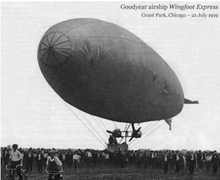The Wingfoot Air Express was an early Goodyear blimp that caught fire and crashed into the Illinois Trust and Savings Building in Chicago on July 21, 1919. The Type FD airship, manufactured and owned by the Goodyear Tire and Rubber Company, was transporting passengers from Grant Park to the White City amusement park.[1] One crew member, two passengers and ten bank employees were killed in what was the worst airship accident in the United States up to that time.
 Wingfoot Air Express | |
| Accident | |
|---|---|
| Date | July 21, 1919 |
| Summary | In-flight fire |
| Site | Chicago, Illinois, United States 41°52′41.25″N 87°37′56.28″W / 41.8781250°N 87.6323000°W |
| Total fatalities | 13 |
| Total injuries | 27 |
| Aircraft | |
| Aircraft type | Type FD dirigible |
| Aircraft name | Wingfoot Air Express |
| Operator | Goodyear Tire and Rubber Company |
| Flight origin | Grant Park, Chicago, Illinois |
| Destination | White City amusement park, Chicago, Illinois |
| Passengers | 2 |
| Crew | 3 |
| Fatalities | 3 (2 passengers, 1 crew) |
| Injuries | 0 |
| Survivors | 2 (2 crew) |
| Ground casualties | |
| Ground fatalities | 10 |
| Ground injuries | 27 |
The crash
editThe airship's flammable hydrogen caught fire for unknown reasons at about 4:55 pm while cruising at an altitude of 1,200 ft (370 m) over the Chicago Loop.[2] When it became clear the dirigible was failing, pilot Jack Boettner and chief mechanic Harry Wacker used parachutes to jump to safety.[3] A second mechanic, Carl Alfred Weaver, died when his parachute caught fire, while passenger Earl H. Davenport, a publicity agent for the White City Amusement Park, had his parachute get tangled in the cables which suspended the gondola from the envelope, leaving him hanging fifty feet below the burning craft; he was killed instantly when the airship crashed.[4] The fifth person who parachuted from the dirigible, Chicago Daily News photographer Milton Norton, broke both legs on landing and later died in hospital.[5]
At the Illinois Trust & Savings Bank[6] building at the northeast corner of LaSalle Street and Jackson Boulevard, 150 employees were closing for the day in and around the main banking hall, which was illuminated by a large skylight. The remains of the blimp struck the bank's skylight, with flaming debris falling through to the banking hall below. Ten employees were killed and 27 injured as a result.
Aftermath
editIn addition to causing the city of Chicago to adopt a new set of rules for aviation over the city, the crash led to the closing of the Grant Park Airstrip and the creation of Chicago Air Park.
See also
editReferences
edit- ^ O'Brien, Ellen; Lyle Benedict (June 2001). "1919, July 21: Dirigible (Balloon) Crash". Deaths, Disturbances, Disasters, and Disorders in Chicago. Chicago Public Library. Archived from the original on 2006-09-27. Retrieved 2007-08-27.
- ^ "The Great Tragedy", The Columns of the Illinois Trust & Savings Bank, Chicago [special memorial issue], p. 3, July 1919, archived from the original on 2006-06-20
- ^ "Wild Plane", Time, 1993-09-04, archived from the original on November 2, 2009
- ^ Krist, Gary (2012). City of Scoundrels: The 12 Days of Disaster that Gave Birth to Modern Chicago. New York: Crown Publisher. p. 14. ISBN 978-0-307-45429-4.
- ^ "11 Killed, 27 Hurt in Blazing Blimp's Fall in Chicago" (PDF), New York Times, 1919-07-22
- ^ "Illinois Bank & Trust". www.illinoisbank.com. Retrieved 2016-09-26.
Further reading
edit- Krist, Gary. City of Scoundrels: The Twelve Days of Disaster That Gave Birth to Modern Chicago. New York: Crown Publisher, 2012. ISBN 978-0-307-45429-4.
- The Columns, Illinois Trust and Savings Bank, July 1919
- Rules adopted by the Chicago City Council, Journal of the Proceedings, April 8, 1921, p. 2230.